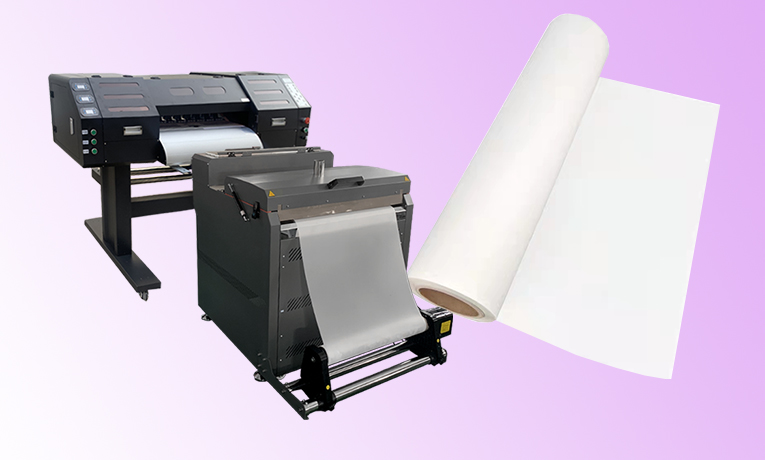DTF Printing VS Heat Transfer Vinyl, Which One Is Better?
DTF Printing VS Heat Transfer Vinyl, Which One Is Better?
DTF Printing VS Heat Transfer Vinyl:
When printing directly to film (DTF), inks are applied to a unique transfer film. You’ll apply the design of the film to a substrate using a heat press machine, and the hot melt powder will serve as the adhesive. Peel off the film once it has returned to room temperature.

The main benefit of DTF printing is its incredible adaptability. Cotton, polyester, and metal are all surfaces that you may simply print designs on! You now have access to incredible customisation for a wide range of products thanks to all of this. DTF-printed design will not fracture or stretch because they are all strong. A DTF print can last for a long period with proper care. Due to the low cost of consumables and equipment, DTF printing is also a financially sensible technique. Starting with DTF printing is far less expensive than starting with direct-to-garment (DTG) printing, enabling you to optimize earnings while maintaining reasonable costs.

What do you think of this heat transfer vinyl (HTV)? While HTV utilizes a special polyurethane-based material for decorating clothing and many other products, such as ceramic mugs, it does have some parallels to DTF printing, particularly in terms of how designs are transferred to the substrate. The carrier, or adhesive backing, on one side of the vinyl substance is what allows it to stick to the surface of the substrate.
With HTV, the desired design is cut out using a specialized vinyl cutter rather than being printed on the vinyl itself. The surplus material will subsequently be weeded away (or removed) with a weeding tool, leaving the design on the carrier. Once the weeding is finished, apply the pattern to the substrate using a heat press, let it cool, and your product is ready to use!
Comparisons with DTF Printing:
Consumables
DTF printing VS Heat Transfer Vinyl have very reasonable consumable costs in comparison. However, in the latter scenario, you save money because you merely need to buy various vinyl sheets. Your vinyl sheets combine the capabilities of all three, so you won’t need to spend money on inks, transfer films, or hot melt powder.
HTV simply entails cutting the vinyl into the desired design, weeding off the excess, and applying it to the substrate with a heat press. With so many various vinyl varieties, you can quickly determine which meets your needs. There is also printable HTV, which enables you to print vivid designs right onto the vinyl paper and cut them out with your vinyl cutter.
If you’re designing a multicolored print or one with a few specialty vinyl designs, the issue with vinyl is that you need to cut off individual sheets of vinyl unless you use something like printable HTV. A single HTV color or style can be used to print a garment fairly easily, but the more intricate or colorful the design, the longer the cutting and weeding process will take.
Production Speed
In comparison to HTV, DTF printing excels in terms of production speed. While it may be true that HTV requires less money to start printing, the lengthy weeding process may increase the amount of time required for production. With DTF, there is no need for weeding because the printer will produce your design, which you can then directly take to the heat press and adhere on the garment.
DTF printing streamlines the procedure by modifying the printer and design software settings. Once everything is calibrated and set up to your preferences, you can begin printing several designs on various sheets of transfer film. Multiple designs printed on a long, wide roll of transfer film can reduce printing time and costs for larger printers.
Print Quality and Durability
For the novices, it may be difficult to distinguish between an HTV print and a DTF one. When you run your palm over the print, both have a feel that is somewhat similar to plastic. However, because of how it was produced, the HTV print is more noticeable. DTF prints are produced using water-based CMYK inks, which are fairly comparable to DTG inks.
The heat and temperature produced by the heat press when the DTF print is applied to the fabric push the inks from the film and onto the surface of the fabric. To make sure the inks are infused into the fabric of the garment, strengthening its durability and wash fastness, a second heat press is advised.
As a result, the hand is reasonably soft and durable; it won’t easily crack or stretch, particularly after a second press. The overall print quality of DTF prints can also be influenced by elements like the quantity of ink or hot melt powder used. Not all hot melt powders are made equal; some may have unique qualities that change how print feels.
The only steps involved in applying HTV are to heat press the vinyl to the substrate, peel the carrier (either a hot, warm, or cold peel), and set the substrate somewhere else to cool. There is no need for a second press because too much heat can weaken the glue on the vinyl and cause the print to tear off. Your main concern with HTV actually has to do with how likely it is that the vinyl may eventually flake off or peel off. In contrast to DTF prints, where the ink has been “pushed” into the fibers on the substrate’s surface, vinyl is “sitting” on the surface of the substrate and is durable and fade-resistant on its own.
